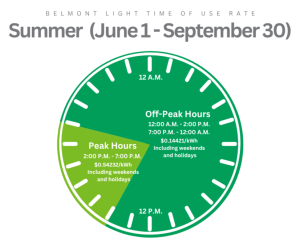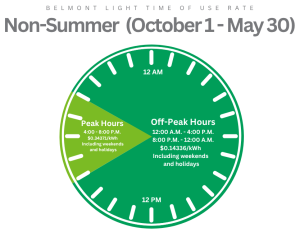A Time of Use Rate pilot program was available to a limited number of customers (150) from January 1 – December 31, 2022. The Municipal Light Board voted to open the rate to an additional 150 customers (for a total number of 300) on a first-come, first-served basis, starting on December 1, 2023. Those 150 spots have been filled. As of July 26, 2024, Belmont Light is no longer accepting customers for the rate. Any questions, please email TimeOfUse@belmontlight.com.
What Are Time of Use Rates?
While the cost for Belmont Light to purchase and deliver electricity to Belmont homes can vary substantially from hour to hour, under the current Residential Rates, these costs are averaged over a year to produce a single flat rate. In contrast, time of use (TOU) rates, also know as time of day rates, are an innovative rate structure that incentivize customers to use electricity when the cost of generating it is lowest and disincentives electricity use when generation costs are highest.
How Do Time of Use Rates Work?
On TOU rates, customers are charged a higher electric rate when the cost of purchasing and delivering electricity is highest (usually late afternoon to early evening) and a lower electric rate when the cost of generating electricity is lower (usually late evening, morning, and midday).
Belmont Light’s Time of Use Rates have two separate time periods – on-peak hours and off-peak hours – which vary based on the time of year. During the Summer (June 1 – September 30), customers are charged more during the peak hours of 2:00 – 7:00 p.m. and less during off-peak hours of 7:00 p.m. – 2:00 p.m. the following day. During non-Summer months (October 1 – May 30), the peak hours are 4:00 p.m. – 8:00 p.m., and off-peak hours are 8:00 p.m. – 4:00 p.m. the following day.
The chart below shows more information on the specific rates:


Why Time of Use Rates?
There are three main reasons for Belmont Light to implement TOU rates. When done correctly, TOU rates: lower costs for customers who are able to shift their electric usage to off-peak times; lower costs for Belmont Light as a whole by reducing the total amount of energy that it is necessary to purchase during peak times; and create more opportunity for a greener power supply since energy is more likely to come from fossil fuel sources during on-peak times.
One of the major goals of TOU rates is to match the costs that customers are charged with the actual cost of delivering electricity to them. Currently, Belmont Light customers pay a flat rate for electricity consumed at any time, whether the cost to Belmont Light is cheap or expensive, throughout the year.
How Do Time of Use Rates Affect My Bill?
The Time of Use Rates are designed to be revenue neutral for the average customer. However, if you are able to shift your electric usage to outside of peak usage periods, you can reduce your electric bills.
Documentation
2021.10.20_TOU Recommendations Memo to MLB_FINAL
2022.06.15 Time of Use Q1 Check-In Webinar Slides
 Service Map
Service Map